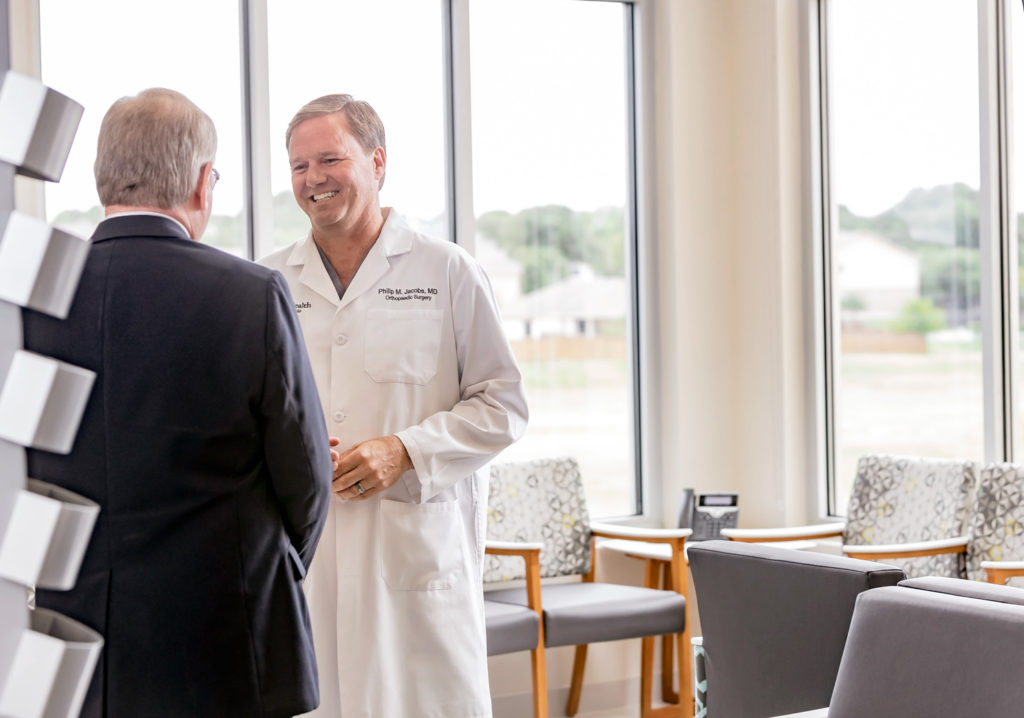A gentleman, a knee injury and value-based care

Boerne resident Philip Pfeiffer was on a trip to Argentina in late December when he felt the pain. “I went there for fishing, but how I hurt my knee, I really don’t know,” he said.
He was already familiar with the UT Health Physicians practice after treatment by faculty orthopedic specialists, including a 2006 right hip replacement performed by Lorence Trick, M.D.
So when he returned from South America with knee pain limiting his activity, Pfeiffer contacted Philip Jacobs, M.D., orthopaedic surgeon with UT Health Physicians.
“I’ve known Phil Jacobs for a number of years and think highly of him,” he said. “Through Dr. Jacobs, I was able to get a very prompt appointment at UT Health Hill Country. The Hill Country facility is very convenient for me, right down Ralph Fair Road from where I live.”
Pfeiffer’s appointment was set for 8:30 a.m. on a Tuesday. He arrived at 8:20 and found that, because he had been a patient of UT Health Physicians before, almost all of the information required to check him in was already in the system.
He was immediately taken for X-rays in the building and, with them completed, met with Dr. Jacobs for the physical examination. Dr. Jacobs made the initial diagnosis of a torn meniscus. The meniscus is cartilage that acts like a shock absorber in the knee.
The appointment concluded at about 9 a.m. Dr. Jacobs asked Pfeiffer to return the same day for magnetic resonance (MR) imaging, also available at Hill Country, to confirm the initial diagnosis.
Pfeiffer returned at 2:30 p.m. and left the facility within two hours with the MRI completed, he said.
“UT Health Hill Country is not just convenient to people in Kendall County, but it also possesses some of the best and latest equipment for expediting testing,” Pfeiffer said. “It is a first-rate facility, easy to get to, and offers a broad spectrum of capabilities to address whatever health issues one might have.”
Rather than immediate surgical repair, Dr. Jacobs recommended a conservative approach of physical therapy and time for healing of Pfeiffer’s torn meniscus. It worked. Pfeiffer is playing golf again, without pain, and has no restrictions.
“I had a first-rate experience and would not hesitate to recommend UT Health Hill Country to others, and I have in fact done so,” Pfeiffer said.
Pfeiffer’s positive experience is not an accident. It is the desired result of the vision of the UT Health Physicians practice, which places an emphasis on value-based care for all patients.
What is value-based care?
“Value-based care focuses the work of a medical practice on quality rather than quantity,” said Ramon Cancino, M.D., M.Sc., director of the Primary Care Center of UT Health Physicians and medical director of primary care at UT Health Hill Country.
This care is patient-centered, timely, effective, safe, efficient and equitable, Dr. Cancino said. It also includes a trusting partnership with patients.
The trust between the patient and the practice providers leads to another feature of value-based care: shared decision making.
“This is the process by which the doctor and patient work together to achieve the outcome most desired by the individual patient,” said Robert H. Quinn, M.D., professor and chairman of the Department of Orthopaedics at UT Health San Antonio. He occupies the John J. Hinchey M.D. and Kathryn Hinchey Chair in Orthopaedics.
In this process, the doctor shares the best available evidence to support each available treatment option, Dr. Quinn said. The result is a mutual decision that achieves the best result while respecting the patient’s individual values, which include cost, time invested in treatment and recovery, convenience and safety/minimization of risk.
“Value-based care is the concept of getting the best ultimate outcome, as reported by the patient over time, for the dollar spent,” said Marc DeHart, M.D., specialist in adult hip and knee reconstruction in the orthopaedics practice of UT Health Physicians.
“Value-based care is about guiding the physician, patient and medical system to do things that make the most measurable difference in the lives of our patients and doing it for the lowest cost needed to get the improvement,” Dr. DeHart continued.
In the case of a torn meniscus—the injury suffered by Philip Pfeiffer—the pain can be from overuse, pre-existing arthritis and other issues, Dr. DeHart said. A substantial number of people over the age of 50 have meniscus tears.
“In many studies, doing arthroscopic knee surgery may show results that are no more effective than watching the knee for two or three months,” Dr. DeHart said.
Magnetic resonance imaging (MRI) and arthroscopy are some of the procedures most frequently cited for overuse and “low value” on a values-based scale, he said.
Some patients don’t want to hear about deferring MRIs and arthroscopy, but rather prefer what they believe is a “quick fix,” Dr. DeHart said. Additionally, current financial rewards of fee-for-service models favor shorter clinic visits, more MRIs and more surgery.
“We all strive to be efficient, to provide convenient service that is satisfying to our patients, but value-based care is more about using our education and resources to make a lasting difference on their health,” Dr. DeHart said. “The ultimate value metric in value-based care is how much the patient’s health has improved over time. To measure this, we use the eventual results reported by the patient and what it cost to get him there.”
Kenyatta Lee, M.D., chief quality officer for UT Health Physicians, said the fee-for-services environment of the last century is diminishing. “Today’s philosophy is, “Do a service if you need to do it. And when you do it, the patients better be satisfied with what you did.”
